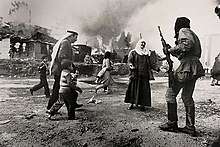Karantina massacre
| Karantina massacre | |
|---|---|
| Part of the Lebanese Civil War | |
 Lebanese refugees Zahra Amcha, Mohammed Amcha and grandchildren Osama and Yahya Amcha in Karantina, 1976 (photo taken by Françoise Demulder)[1] | |
 Beirut Beirut (Lebanon) | |
| Location | Beirut, Lebanon |
| Coordinates | 33°53′13″N 35°30′47″E / 33.88694°N 35.51306°E |
| Date | January 18, 1976 |
| Target | Karantina district of Beirut |
Attack type | Massacre |
| Deaths | ~1,500 |
| Perpetrators | Kataeb, Guardians of the Cedars, Tiger militia[2] |
| Motive | Securing territory |
The Karantina massacre took place early in the Lebanese Civil War on January 18, 1976. With the breakdown in authority of the Lebanese government the militancy of radical factions increased.[3]
Karantina was a predominantly Palestinian Muslim slum district in mostly Christian east Beirut controlled by forces of the Palestine Liberation Organization (PLO),[4] inhabited by Kurds, Syrians, Armenians[5] and Palestinians.[6] The fighting and subsequent killings also involved an old quarantine area near the port and nearby Maslakh quarter.[7][8][9]
Karantina was overrun by militias of the right-wing and mostly Christian Lebanese Front, specifically the Kataeb Party (Phalangists),[10][11] resulting in the deaths of approximately 1,500 people, mostly Muslims.[8] After Kataeb Regulatory Forces (KRF), Guardians of the Cedars (GoC), NLP Tiger militia and Lebanese Youth Movement (LYM) forces took control of the Karantina district on 18 January 1976, Tel al-Zaatar was placed under siege, leading to the Tel al-Zaatar massacre.[2]
The Damour massacre was a reprisal for the Karantina massacre.[8][12]
See also
Footnotes
- ↑ 1976 - World Press Photo
- 1 2 Kazziha, Walid (1979) Palestine in the Arab dilemma Taylor & Francis, ISBN 0-85664-864-7 p 52
- ↑ Kissinger, Henry (1999) Years of Renewal Simon Schuster, ISBN 1-84212-042-5 p 1022
- ↑ Noam Chomsky (1989) Necessary Illusions: Thought Control in Democratic Societies South End Press, ISBN 0-89608-366-7 p 171
- ↑ Jonathan C. Randal (1990) The Tragedy of Lebanon: Christian Warlords, Israeli Adventurers and American Bunglers Hogarth, ISBN 0-7012-0909-7 p 88-90
- ↑ Michael Johnson (2001) All Honourable Men: The Social Origins of War in Lebanon I.B.Tauris, ISBN 1-86064-715-4 p 62
- ↑ Lokman I. Meho, Kelly L. Maglaughlin (2001) Kurdish culture and society: an annotated bibliography Greenwood Publishing Group, ISBN 0-313-31543-4 p 35
- 1 2 3 Harris (p. 162) notes "the massacre of 1,500 Palestinians, Shi'is, and others in Karantina and Maslakh, and the revenge killings of hundreds of Christians in Damur"
- ↑ Jonathan C. Randal (1990) The Tragedy of Lebanon: Christian Warlords, Israeli Adventurers and American Bunglers Hogarth, ISBN 0-7012-0909-7 p 88
- ↑ William W. Harris (January 2006). The New Face of Lebanon: History's Revenge. Markus Wiener Publishers. p. 162. ISBN 978-1-55876-392-0. Retrieved July 27, 2013.
the massacre of 1,500 Palestinians, Shi'is, and others in Karantina and Maslakh, and the revenge killings of hundreds of Christians in Damour
- ↑ Noam Chomsky, Edward W. Said (1999) Fateful Triangle: The United States, Israel, and the Palestinians South End Press, ISBN 0-89608-601-1 pp 184–185
- ↑ Noam Chomsky, Edward W. Said (1999) Fateful Triangle: The United States, Israel, and the Palestinians South End Press, ISBN 0-89608-601-1 pp 184-185
Bibliography
- Chomsky, Noam (1989) Necessary Illusions: Thought Control in Democratic Societies South End Press, ISBN 0-89608-366-7
- Fisk, Robert (2001) Pity the Nation: Lebanon at War Oxford University Press, ISBN 0-19-280130-9,
- William Harris, (1996) Faces of Lebanon. Sects, Wars, and Global Extensions Markus Wiener Publishers, Princeton, USA ISBN 1-55876-115-2